Ethylene oxide in foods: still a long way to go in reaching coordination
01 July 2021
In the past few months, organisations have revealed that non-compliant products containing ingredients illegally processed with ethylene oxide were still being sold without proper consumer information.
Ethylene oxide is a gaseous disinfectant, originally used for sterilization purposes and for decreasing salmonella occurrence in foods. It is a highly irritating and mutagenic chemical, considered to be increasing miscarriage risks, genetic anomalies and cancer occurrence in humans, all-the-while impacting the animal reproductive cycle. It has been banned in the EU as a pesticide since 1991 and as an output product in food and feed since 2011.
Food Watch specifically showed that while countries like France follow the precautionary principle and routinely recall products, it is not the case for all European countries. Besides, the NGO claims that the European Commission and Member States are contemplating easing recalls for products illegally processed but for which operators would not be able to identify contaminations below a detectable threshold.
These worrying information constitute another step in the ethylene oxide saga. As recently as last March, hundreds of products (including pastries, breads, spice mixes…) were recalled across over ten Member States for containing sesame seeds originating from India.
Alerts have namely been raised by notifying the Rapid Alert System for Food and Feed (RASFF), the European surveillance tool aimed at facilitating information sharing amongst national sanitary authorities.
However, these discrepancies in practice show the clear need for reinforcing the tracing and recalling procedures of products, all-the-while underlining the issue of responsibility of national operators. Finally, it also emphasizes the lack of information provided to the general public, which can turn out as highly misleading.



